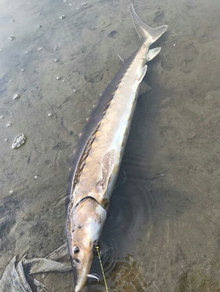 This August, a fisherman casting downstream of the Vernon Dam (in Vernon, Vermont) on the Connecticut River had quite a surprise when he reeled in not a walleye or bass, but instead a relic from the age of dinosaurs: an adult-sized shortnose sturgeon!
Sturgeon are among the most primitive of the bony fishes, and have five rows of bony plates or “scutes” covering their bodies. More than once, these odd-looking ancients have been mistaken for sea monsters. Shortnose sturgeon are the smallest of the sturgeon species that live in North America, and have been listed as endangered since 1967. As part of our Recovery Plan for the species, we monitor their populations in a number of rivers along the U.S. East Coast.
This sturgeon, which was released alive (above, photo courtesy of NH Fish & Game, USGS), is the first documented report of a shortnose sturgeon in the Connecticut River upstream of the Turners Falls Dam (in Turners Falls, Massachusetts). Sturgeon researchers at the USGS Conte Anadromous Fish Lab confirmed that this was indeed a shortnose sturgeon.
Although shortnose sturgeon sometimes jump out of the water, they don’t leap to overcome migration obstacles like salmon do, so researchers and managers were fairly certain that steep falls like Great Falls, where the Turners Falls Dam was built in 1905, blocked sturgeon access to the upstream reaches of the Connecticut River. In fact, it has been widely accepted that the range of Connecticut River shortnose sturgeon was from the mouth of the river at Long Island Sound to the Turners Falls Dam. After word of this catch got around, we heard about other sturgeon sightings between the Turners Falls Dam and the Vernon Dam, as well as between the Vernon Dam and the Bellows Falls Dam (in Bellows Falls, Vermont). No sightings upstream of the Vernon Dam have been verified.
Find out more about shortnose sturgeon and read the rest of the story on our website.
|